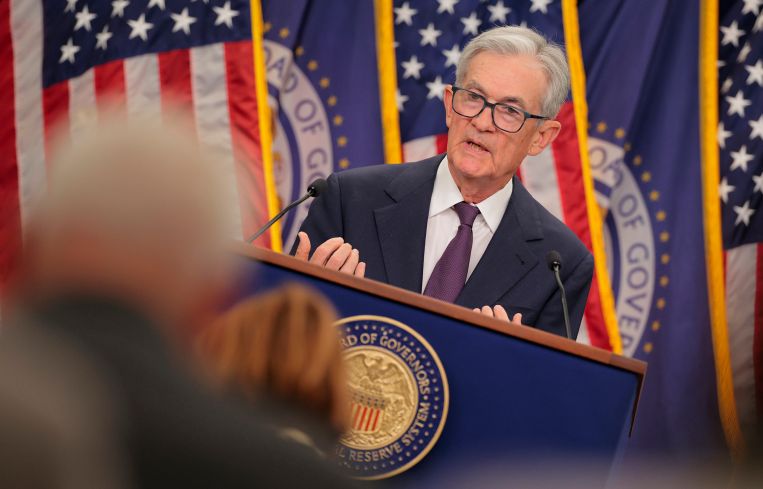Fed’s Second Straight Cut Has Commercial Real Estate Predicting Busier 2026
By Andrew Coen October 29, 2025 2:10 pm
reprints
The Federal Reserve enacted its second straight quarter-point interest rate cut Wednesday, dropping short-term borrowing levels down to the high 3 percent range for the first time in three years.
In an 10-2-vote, the central bank reduced its benchmark interest rate by 25 basis points to between 3.75 percent and 4 percent while not signaling whether a continued downward path would continue for upcoming meetings. The back-to-back Federal Open Market Committee (FOMC) cuts come on the heels of five straight rate pauses to open 2025 following three cuts in late 2024, after rates had hovered between 5.25 percent and 5.5 percent from July 2023 to September 2024.
Fed Chair Jerome Powell stressed in a post-meeting press conference that whether the FOMC implements another cut at its December meeting is up in the air. FOMC committee members had forecasted a December cut based on the Fed’s latest quarterly “dot plot” released in September.
“In the committee’s discussions at this meeting, there were strongly differing views about how to proceed in December,” Powell said. “A further reduction in the policy rate at the December meeting is not a foregone conclusion. Far from it.”
The central bank’s vote came amid a backdrop of President Donald Trump’s push for political control of the Fed, while also demanding the central bank lower interest rates. Trump has attempted to fire Fed Governor Lisa Cook, who President Joe Biden appointed to a 14-year term that expires in 2038, citing allegations of mortgage fraud which are now playing out in the courts. Trump has also sought to fire Fed Chair Jerome Powell before his term expires in May 2026. (The U.S. Supreme Court will hear an appeal from Cook in January.)
The Fed is facing challenges on both sides of its dual mandate with the unemployment rate reaching a four-year high of 4.3 percent in August and inflation hitting 3 percent in the latest Consumer Price Index (CPI). The CPI report marked the only data release from the Bureau of Labor Statistics (BLS) since Trump suspended the reports following the firing of Dr. Erika McEntarfer as the BLS commissioner on Aug. 1.
Powell said a lack of economic data could affect how the FOMC approaches any decision with the December meeting. He said the Fed remains committed to its longstanding goal of bringing inflation down to a 2 percent level.
Jay Neveloff, partner and chair of U.S. real estate at global law firm HSF Kramer, said he has noticed an uptick in deal activity among CRE clients since the Fed’s September cut, with lenders proactive in seeking transactions. Neveloff noted lenders are more motivated to enforce terms of existing loans as repricing makes valuations clearer. That could pave the way for an active 2026 if rates continue to trend downward.
“I think that the closer and closer some lenders get to the realization of going into an enforcement method if they can’t compel a restructuring of the debt, they’re going to start trading loans,” Neveloff said. “I think that 2026 is going to be a terrific year for transactions, and some will be opportunistic and some will be painful.”
Steven A. Shoumer, co-chair of Blank Rome‘s real estate practice group, also said he has seen more confidence from clients in future deal flow amid expectations of lower interest rates. Shoumer noted that more traditional banks have begun to get active with lending again in addition to private lenders that had been leading the charge the last couple of years. That sets up a potentially very robust 2026 for CRE originations volume.
“We’re starting to see the more traditional banks not going full bore by any means but starting to come back with more opportunities than we were seeing,” said Shoumer, who works with lender and developer clients. “They’re still being more selective and making sure the asset is a good asset and the sponsor is a good sponsor, but we are seeing that thawing very much compared to the last couple of years.”
Stephanie Wiggins, head of agency and Federal Housing Administration production with PGIM‘s real estate business, said she has urged borrowers to consider locking in interest rates now in light of 10-year U.S. Treasury yields dipping below 4 percent last week. She noted that while there is an outlook for interest rates to continue settling lower, many multifamily owners are opting for short-term deals that provide more flexibility.
Wiggins said there is a large pipeline of agency-backed loans at the end of this year that is positioning volume at PGIM to be as busy as 2020-2021 levels, aided by interest rates stabilizing and the investment sales market slowly bouncing back.
“Across the agency lending community, lenders are reporting healthy pipelines as owner-operators buy into the optimism that has accompanied the week-over-week decrease in rates coupled with ‘let’s win deals’ mindsets at both Fannie and Freddie,” Wiggins said, referring to the government-backed mortgage market giants. “This fourth quarter will require a marshalling of resources to get it all done as borrowers are ready to move forward and strike while the iron is hot.”
Andrew Coen can be reached at acoen@commercialobserver.com.


